Alien Plants of Kyrgyzstan: The First Complete Inventory, Distributions and Main Patterns
Abstract
1. Introduction
2. Materials and Methods
2.1. Study Area
2.2. Data Collection
2.3. Data Analysis
3. Results
4. Discussion
5. Conclusions
Supplementary Materials
Author Contributions
Funding
Data Availability Statement
Acknowledgments
Conflicts of Interest
References
- Simberloff, D.; Martin, J.-L.; Genovesi, P.; Maris, V.; Wardle, D.A.; Aronson, J.; Courchamp, F.; Galil, B.; García-Berthou, E.; Pascal, M.; et al. Impacts of biological invasions: What’s what and the way forward. Trends Ecol. Evol. 2013, 28, 58–66. [Google Scholar] [CrossRef]
- Rai, P.K.; Singh, J.S. Invasive alien plant species: Their impact on environment, ecosystem services and human health. Ecol. Indic. 2020, 111, 106020. [Google Scholar] [CrossRef]
- Lazzaro, L.; Bolpagni, R.; Buffa, G.; Gentili, R.; Lonati, M.; Stinca, A.; Acosta, A.T.R.; Adorni, M.; Aleffi, M.; Allegrezza, M.; et al. Impact of invasive alien plants on native plant communities and Natura 2000 habitats: State of the art, gap analysis and perspectives in Italy. J. Environ. Manag. 2020, 274, 111140. [Google Scholar] [CrossRef]
- Haubrock, P.J.; Turbelin, A.J.; Cuthbert, R.N.; Novoa, A.; Taylor, N.G.; Angulo, E.; Ballesteros-Mejia, L.; Bodey, T.W.; Capinha, C.; Diagne, C.; et al. Economic costs of invasive alien species across Europe. NeoBiota 2021, 67, 153–190. [Google Scholar] [CrossRef]
- Booy, O.; Cornwall, L.; Parrott, D.; Sutton-Croft, M.; Williams, F. Impact of biological invasions on infrastructure. In Impact of Biological Invasions on Ecosystem Services; Vilà, M., Hulme, P.E., Eds.; Springer International: Cham, Switzerland, 2017; pp. 235–247. [Google Scholar] [CrossRef]
- Lazzaro, L.; Essl, F.; Lugliè, A.; Padedda, B.M.; Pyšek, P.; Brundu, G. Invasive Alien Plant Impacts on Human Health and Well-Being–Invasive Species and Human Health; CAB International: Wallingford, UK, 2018; pp. 16–33. [Google Scholar]
- Shackleton, R.T.; Shackleton, C.M.; Kull, C.A. The role of invasive alien species in shaping local livelihoods and human well-being: A review. J. Environ. Manag. 2019, 229, 145–157. [Google Scholar] [CrossRef]
- Kalisz, S.; Kivlin, S.N.; Bialic-Murphy, L. Allelopathy is pervasive in invasive plants. Biol. Invasions 2021, 23, 367–371. [Google Scholar] [CrossRef]
- Bleeker, W.; Schmitz, U.; Ristow, M. Interspecific hybridisation between alien and native plant species in Germany and its consequences for native biodiversity. Biol. Conserv. 2007, 137, 248–253. [Google Scholar] [CrossRef]
- Fletcher, R.A.; Brooks, R.K.; Lakoba, V.T.; Sharma, G.; Heminger, A.R.; Dickinson, C.C.; Barney, J.N. Invasive plants negatively impact native, but not exotic, animals. Glob. Chang. Biol. 2019, 25, 3694–3705. [Google Scholar] [CrossRef]
- Foxcroft, L.C.; Richardson, D.M.; Pyšek, P.; Genovesi, P. Invasive alien plants in protected areas: Threats, opportunities, and the way forward. In Plant Invasions in Protected Areas: Patterns, Problems and Challenges; Foxcroft, L.C., Pyšek, P., Richardson, D.M., Genovesi, P., Eds.; Springer: Dordrecht, The Netherlands, 2013; Volume 7, pp. 621–639. [Google Scholar] [CrossRef]
- Genovesi, P.; Carboneras, C.; Vilà, M.; Walton, P. EU adopts innovative legislation on invasive species: A step towards a global response to biological invasions? Biol. Invasions 2015, 17, 1307–1311. [Google Scholar] [CrossRef]
- Meyerson, L.A.; Pauchard, A.; Brundu, G.; Carlton, J.T.; Hierro, J.L.; Kueffer, C.; Pandit, M.K.; Pyšek, P.; Richardson, D.M.; Packer, J.G. Moving toward Global Strategies for Managing Invasive Alien Species. In Global Plant Invasions; Clements, D.R., Upadhyaya, M.K., Joshi, S., Shrestha, A., Eds.; Springer: Cham, Switzerland, 2022; pp. 331–360. [Google Scholar] [CrossRef]
- McNeely, J.A. (Ed.) The Great Reshuffling: Human Dimensions of Invasive Alien Species; IUCN: Gland, Switzerland; Cambridge, UK, 2001; vi + 242p; ISBN 2-8317-0602-5. [Google Scholar]
- Monaco, T.J.; Weller, S.C.; Ashton, F.M. Weed Science: Principles and Practices, 4th ed.; Wiley-Blackwell: New York, NY, USA, 2002; 688p, ISBN 9780471370512. [Google Scholar]
- van Kleunen, M.; Essl, F.; Pergl, J.; Brundu, G.; Carboni, M.; Dullinger, S.; Early, R.; González-Moreno, P.; Groom, Q.J.; Hulme, P.E.; et al. The changing role of ornamental horticulture in alien plant invasions. Biol. Rev. 2018, 93, 1421–1437. [Google Scholar] [CrossRef]
- Vilà, M.; Espinar, J.L.; Hejda, M.; Hulme, P.E.; Jarošík, V.; Maron, J.L.; Pergl, J.; Schaffner, U.; Sun, Y.; Pyšek, P. Ecological impacts of invasive alien plants: A meta-analysis of their effects on species, communities and ecosystems. Ecol. Lett. 2011, 14, 702–708. [Google Scholar] [CrossRef]
- Pyšek, P.; Pergl, J.; Essl, F.; Lenzner, B.; Dawson, W.; Kreft, H.; Weigelt, P.; Winter, M.; Kartesz, J.; Nishino, M.; et al. Naturalized alien flora of the world: Species diversity, taxonomic and phylogenetic patterns, geographic distribution and global hotspots of plant invasion. Preslia 2017, 89, 203–274. [Google Scholar] [CrossRef]
- van Kleunen, M.; Pyšek, P.; Dawson, W.; Essl, F.; Kreft, H.; Pergl, J.; Weigelt, P.; Stein, A.; Dullinger, S.; König, C.; et al. The Global Naturalized Alien Flora (GloNAF) database. Ecology 2019, 100, e02542. [Google Scholar] [CrossRef]
- Sennikov, A.N.; Tojibaev, K.S.; Beshko, N.Y.; Esanov, H.K.; Wong, L.J.; Pagad, S. Global Register of Introduced and Invasive Species–Uzbekistan; Checklist Dataset; Invasive Species Specialist Group ISSG: Rome, Italy, 2020. [Google Scholar] [CrossRef]
- Pagad, S.; Genovesi, P.; Carnevali, L.; Schigel, D.; McGeoch, M.A. Introducing the Global Register of Introduced and Invasive Species. Sci. Data 2018, 5, 170202. [Google Scholar] [CrossRef]
- Sennikov, A.N.; Tojibaev, K.S.; Khassanov, F.O.; Beshko, N.Y. The Flora of Uzbekistan Project. Phytotaxa 2016, 282, 107–118. [Google Scholar] [CrossRef]
- Sennikov, A.N. (Ed.) Flora of Uzbekistan; Navruz Publishers: Tashkent, Uzbekistan, 2016; Volume 1, xxviii + 173p; ISBN 978-9943-381-82-7. [Google Scholar]
- Sennikov, A.N. (Ed.) Flora of Uzbekistan; Navruz Publishers: Tashkent, Uzbekistan, 2017; Volume 2, xii + 200p; ISBN 978-9943-381-33-9. [Google Scholar]
- Sennikov, A.N. (Ed.) Flora of Uzbekistan; Ma’naviyat Publishers: Tashkent, Uzbekistan, 2019; Volume 3, xii + 201p; ISBN 978-9943-04-395-4. [Google Scholar]
- Sennikov, A.N. (Ed.) Flora of Uzbekistan; Science Publishers: Tashkent, Uzbekistan, 2022; Volume 4, xviii + 238p; ISBN 978-9943-19-645-2. [Google Scholar]
- Sennikov, A.N. (Ed.) Flora of Uzbekistan; Science Publishers: Tashkent, Uzbekistan, 2023; Volume 5, xiv + 469p; ISBN 978-9943-19-6765-9. [Google Scholar]
- Sennikov, A.N. (Ed.) Flora of Uzbekistan; Ma’naviyat Publishers: Tashkent, Uzbekistan, 2023; Volume 6, xiv + 209p; ISBN 978-9943-04-498-2. [Google Scholar]
- Makhkamov, T.K.; Brundu, G.; Jabborov, A.M.; Gaziev, A.D. Predicting the potential distribution of Ranunculus sardous (Ranunculaceae), a new alien species in the flora of Uzbekistan and Central Asia. BioInvasions Rec. 2023, 12, 63–77. [Google Scholar] [CrossRef]
- Sennikov, A.N.; Lazkov, G.A.; Wong, L.J.; Pagad, S. Global Register of Introduced and Invasive Species–Kyrgyzstan; Checklist Dataset; Invasive Species Specialist Group ISSG: Rome, Italy, 2021. [Google Scholar] [CrossRef]
- Lazkov, G.A.; Sultanova, B.A. Checklist of Vascular Plants of Kyrgyzstan; United Nations Development Programme: Bishkek, Kyrgyzstan, 2014; 125p. [Google Scholar]
- Schischkin, B.K. (Ed.) Flora of the Kyrgyz SSR. Manual of Vascular Plants of the Kyrgyz SSR; Kyrgyz SSR Branch of the Academy of Sciences of the USSR: Frunze, USSR, 1952; Volume 1, 104p. [Google Scholar]
- Schischkin, B.K. (Ed.) Flora of the Kyrgyz SSR. Manual of Vascular Plants of the Kyrgyz SSR; Kyrgyz SSR Branch of the Academy of Sciences of the USSR: Frunze, USSR, 1950; Volume 2, 315p. [Google Scholar]
- Vvedensky, A.I. (Ed.) Flora of the Kyrgyz SSR. Manual of Vascular Plants of the Kyrgyz SSR; Kyrgyz SSR Branch of the Academy of Sciences of the USSR: Frunze, USSR, 1951; Volume 3, 150p. [Google Scholar]
- Vvedensky, A.I. (Ed.) Flora of the Kyrgyz SSR. Manual of Vascular Plants of the Kyrgyz SSR; Kyrgyz SSR Branch of the Academy of Sciences of the USSR: Frunze, USSR, 1953; Volume 4, 156p. [Google Scholar]
- Vvedensky, A.I. (Ed.) Flora of the Kyrgyz SSR. Manual of Vascular Plants of the Kyrgyz SSR; Academy of Sciences of the Kyrgyz SSR: Frunze, USSR, 1955; Volume 5, 187p. [Google Scholar]
- Vvedensky, A.I. (Ed.) Flora of the Kyrgyz SSR. Manual of Vascular Plants of the Kyrgyz SSR; Academy of Sciences of the Kyrgyz SSR: Frunze, USSR, 1955; Volume 6, 299p. [Google Scholar]
- Vvedensky, A.I. (Ed.) Flora of the Kyrgyz SSR. Manual of Vascular Plants of the Kyrgyz SSR; Academy of Sciences of the Kyrgyz SSR: Frunze, USSR, 1957; Volume 7, 643p. [Google Scholar]
- Vvedensky, A.I. (Ed.) Flora of the Kyrgyz SSR. Manual of Vascular Plants of the Kyrgyz SSR; Academy of Sciences of the Kyrgyz SSR: Frunze, USSR, 1959; Volume 8, 223p. [Google Scholar]
- Vvedensky, A.I. (Ed.) Flora of the Kyrgyz SSR. Manual of Vascular Plants of the Kyrgyz SSR; Academy of Sciences of the Kyrgyz SSR: Frunze, USSR, 1960; Volume 9, 214p. [Google Scholar]
- Vvedensky, A.I. (Ed.) Flora of the Kyrgyz SSR. Manual of Vascular Plants of the Kyrgyz SSR; Academy of Sciences of the Kyrgyz SSR: Frunze, USSR, 1962; Volume 10, 388p. [Google Scholar]
- Vvedensky, A.I. (Ed.) Flora of the Kyrgyz SSR. Manual of Vascular Plants of the Kyrgyz SSR; Science Publishers: Frunze, USSR, 1965; Volume 11, 610p. [Google Scholar]
- Vykhodtsev, I.V. (Ed.) Flora of the Kyrgyz SSR; Science Publishers: Frunze, USSR, 1967; Supplement 1; 149p. [Google Scholar]
- Lebedeva, L.P. (Ed.) Flora of the Kyrgyz SSR; Science Publishers: Frunze, USSR, 1970; Supplement 2; 64p. [Google Scholar]
- Deza, M.I. Weedy Plants of Kirghizia; Kyrgyzstan Publishers: Frunze, USSR, 1983; 152p. [Google Scholar]
- Deza, M.I. Manual of Weedy Plants of Kirghizia; Kyrgyzstan Publishers: Frunze, USSR, 1989; 204p, ISBN 5-655-00308-2. [Google Scholar]
- Sennikov, A.N.; Lazkov, G.A.; Uotila, P.; Weber, H. Taxonomic corrections and new records in vascular plants of Kyrgyzstan. Memoranda Soc. Fauna Flora Fenn. 2011, 87, 41–64. [Google Scholar]
- Lazkov, G.A.; Sennikov, A.N. New records in vascular plants alien to Kyrgyzstan. Biodivers. Data J. 2014, 2, e1018. [Google Scholar] [CrossRef]
- Lazkov, G.A.; Sennikov, A.N.; Koichubekova, G.A.; Naumenko, A.N. Taxonomic corrections and new records in vascular plants of Kyrgyzstan, 3. Memoranda Soc. Fauna Flora Fenn. 2014, 90, 91–110. [Google Scholar]
- Lazkov, G.A.; Sennikov, A.N. Taxonomic corrections and new records in vascular plants of Kyrgyzstan, 4. Memoranda Soc. Fauna Flora Fenn. 2015, 91, 67–83. [Google Scholar]
- Lazkov, G.A.; Sennikov, A.N. Taxonomic corrections and new records in vascular plants of Kyrgyzstan, 5. Memoranda Soc. Fauna Flora Fenn. 2017, 93, 79–100. [Google Scholar]
- Tojibaev, K.S.; Sennikov, A.N.; Lazkov, G.A.; Jang, C.-G.; Choi, H.-J.; Chang, K.S.; Jung, S.-Y.; Kim, A.; Choi, K. Checklist of Vascular Plants of the Tian-Shan Mountain System; Korea National Arboretum: Pocheon, Republic of Korea, 2021; 607p, ISBN 979-11-90509-72-5 (93480). [Google Scholar]
- Sennikov, A.N.; Lazkov, G.A. The first checklist of alien vascular plants of Kyrgyzstan, with new records and critical evaluation of earlier data. Contribution 1. Biodivers. Data J. 2021, 9, e75590. [Google Scholar] [CrossRef]
- Sennikov, A.N.; Lazkov, G.A. The first checklist of alien vascular plants of Kyrgyzstan, with new records and critical evaluation of earlier data. Contribution 2. Biodivers. Data J. 2022, 10, e80804. [Google Scholar] [CrossRef] [PubMed]
- Sennikov, A.N.; Lazkov, G.A. Alien Plants of Kyrgyzstan; Occurrence Dataset; Komarov Botanical Institute: St Petersburg, Russia, 2021. [Google Scholar] [CrossRef]
- Li, W.; Tojibaev, K.S.; Hisoriev, H.; Shomurodov, K.F.; Luo, M.; Feng, Y.; Ma, K. Mapping Asia Plants: Current status of floristic information for Central Asian flora. Glob. Ecol. Conserv. 2020, 24, e01220. [Google Scholar] [CrossRef]
- Otorbaev, K.O.; Lunin, B.A.; Blagoobrazov, V.A. (Eds.) Nature of Kirghizia: A Brief Account of Physical Geography; State Publishers of the Kirghiz SSR: Frunze, USSR, 1962; 296p. [Google Scholar]
- Ömürzakov, S.Ö. (Ed.) Atlas of the Kirghizian Soviet Socialist Republic; The Department of Geodesy and Cartography, Council of Ministers of the USSR: Moscow, USSR, 1987; Volume 1. [Google Scholar]
- Lazkov, G.A.; Sennikov, A.N. Taxonomy of two blue-flowered juno irises (Iris subgen. Scorpiris, Iridaceae) from the Western Tian-Shan. Ann. Bot. Fenn. 2017, 54, 297–305. [Google Scholar] [CrossRef]
- Sennikov, A.N.; Lazkov, G.A. Taxonomic revision of the Allium filidens group (Amaryllidaceae) in Kyrgyzstan. Nord. J. Bot. 2023, 2023, e04050. [Google Scholar] [CrossRef]
- Lazkov, G.A.; Sennikov, A.N. Ligularia philanthrax (Asteraceae), a new species from a coal mining region of Kyrgyzstan. Ann. Bot. Fenn. 2019, 56, 355–359. [Google Scholar] [CrossRef]
- Lazkov, G.A.; Sennikov, A.N. Euphorbia talassica (E. sect. Esula, Euphorbiaceae), a new species of leafy spurges from the Western Tian-Shan. Ann. Bot. Fenn. 2018, 56, 135–143. [Google Scholar] [CrossRef]
- Sennikov, A.N.; Lazkov, G.A. Taxonomic revision and reclassification of Pseudolinosyris with related taxa in Galatella (Asteraceae). Ann. Bot. Fenn. 2020, 57, 367–375. [Google Scholar] [CrossRef]
- Kirschner, J.; Štěpánek, J.; Klimeš, L.; Dvorský, M.; Brůna, J.; Macek, M.; Kopecký, M. The Taraxacum Flora of Ladakh, with notes on the adjacent regions of the West Himalaya. Phytotaxa 2020, 457, 1–409. [Google Scholar] [CrossRef]
- Kirschner, J.; Štěpánek, J. Dandelions in Central Asia: A revision of Taraxacum section Stenoloba. Preslia 2011, 83, 491–512. [Google Scholar]
- Kirschner, J.; Štěpánek, J. A revision of Taraxacum sect. Atrata, a dandelion group centred in the Middle Asia, and the problem of Taraxacum brevirostre. Phytotaxa 2017, 305, 225–261. [Google Scholar] [CrossRef]
- Kirschner, J.; Štěpánek, J. A taxonomic revision of Taraxacum sect. Dissecta, a continental steppe group common in Siberia and adjacent regions of Central Asia. Phytotaxa 2023, 590, 1–67. [Google Scholar] [CrossRef]
- The Angiosperm Phylogeny Group. An update of the Angiosperm Phylogeny Group classification for the orders and families of flowering plants: APG IV. Bot. J. Linn. Soc. 2016, 181, 1–20. [Google Scholar] [CrossRef]
- IUCN. IUCN EICAT Categories and Criteria–The Environmental Impact Classification for Alien Taxa; IUCN: Gland, Switzerland; Cambridge, UK, 2020; 22p. [Google Scholar]
- Sennikov, A.N.; Lazkov, G.A. Alien Plants of Kyrgyzstan; Checklist Dataset; Komarov Botanical Institute, Russian Academy of Sciences: St. Petersburg, Russia, 2023. [Google Scholar] [CrossRef]
- Hulme, P.E.; Bacher, S.; Kenis, M.; Klotz, S.; Kühn, I.; Minchin, D.; Nentwig, W.; Olenin, S.; Panov, V.; Pergl, J.; et al. Grasping at the routes of biological invasions: A framework for integrating pathways into policy. J. Appl. Ecol. 2008, 45, 403–414. [Google Scholar] [CrossRef]
- Sohrabi, S.; Naqinezhad, A.; Kortz, A.; Hejda, M.; Gherekhloo, J.; Zand, E.; Pergl, J.; Brundu, G.; Pyšek, P. Alien flora of Iran: Species status, introduction dynamics, habitats and pathways. Biol. Invasions 2023, 25, 1359–1371. [Google Scholar] [CrossRef]
- Richardson, D.M.; Pyšek, P.; Rejmánek, M.; Barbour, M.G.; Panetta, F.D.; West, C.J. Naturalization and invasion of alien plants: Concepts and definitions. Divers. Distrib. 2000, 6, 93–107. [Google Scholar] [CrossRef]
- Pyšek, P.; Sádlo, J.; Chrtek, J.; Chytrý, M.; Kaplan, Z.; Pergl, J.; Pokorná, A.; Axmanová, I.; Čuda, J.; Doležal, J.; et al. Catalogue of alien plants of the Czech Republic (3rd edition): Species richness, status, distributions, habitats, regional invasion levels, introduction pathways and impacts. Preslia 2022, 94, 447–577. [Google Scholar] [CrossRef]
- van Kleunen, M.; Dawson, W.; Essl, F.; Pergl, J.; Winter, M.; Weber, E.; Kreft, H.; Weigelt, P.; Kartesz, J.; Nishino, M.; et al. Global exchange and accumulation of non-native plants. Nature 2015, 525, 100–103. [Google Scholar] [CrossRef]
- Pyšek, P.; Hulme, P.E.; Simberloff, D.; Bacher, S.; Blackburn, T.M.; Carlton, J.T.; Dawson, W.; Essl, F.; Foxcroft, L.C.; Genovesi, P.; et al. Scientists’ warning on invasive alien species. Biol. Rev. 2020, 95, 1511–1534. [Google Scholar] [CrossRef]
- Vvedensky, A.I. (Ed.) Flora of Uzbekistan; Academy of Sciences of the Uzbek SSR: Tashkent, USSR, 1962; Volume 6, 631p. [Google Scholar]
- Rasulova, M.R. (Ed.) Flora of the Tajik SSR; Science Publishers: Leningrad, USSR, 1991; Volume 10, 619p. [Google Scholar]
- POWO. Plants of the World Online. Facilitated by the Royal Botanic Gardens, Kew. Available online: http://www.plantsoftheworldonline.org/ (accessed on 11 January 2024).
- Lazkov, G.A.; Milko, D.A.; Neveraev, U.A. Salvia aethiopis (Lamiaceae), a new alien species for the flora of Kyrgyzstan. Turczaninowia 2012, 15, 41–43. [Google Scholar]
- Häkkinen, H.; Hodgson, D.; Early, R. Plant naturalizations are constrained by temperature but released by precipitation. Glob. Ecol. Biogeogr. 2022, 31, 501–514. [Google Scholar] [CrossRef]
- Gutterman, Y. Survival Strategies of Annual Desert Plants; Springer: Berlin/Heidelberg, Germany, 2002; 348p. [Google Scholar] [CrossRef]
- Peel, M.C.; Finlayson, B.L.; McMahon, T.A. Updated world map of the Köppen-Geiger climate classification. Hydrol. Earth Syst. Sci. 2007, 11, 1633–1644. [Google Scholar] [CrossRef]
- Lambdon, P.W.; Pyšek, P.; Basnou, C.; Hejda, M.; Arianoutsou, M.; Essl, F.; Jarošík, V.; Pergl, J.; Winter, M.; Anastasiu, P.; et al. Alien flora of Europe: Species diversity, temporal trends, geographical patterns and research needs. Preslia 2008, 80, 101–149. [Google Scholar]
- Funk, V.A.; Susanna, A.; Stuessy, T.F.; Bayer, R.J. (Eds.) Systematics, Evolution, and Biogeography of Compositae; IAPT: Vienna, Austria, 2009; 965p. [Google Scholar]
- Kudryashev, S.N. (Ed.) Flora of Uzbekistan; Uzbekistan Branch of the Academy of Sciences of the USSR: Tashkent, USSR, 1941; Volume 1, 568p. [Google Scholar]
- Vvedensky, A.I. (Ed.) Flora of Uzbekistan; Academy of Sciences of the Uzbek SSR: Tashkent, USSR, 1953; Volume 2, 551p. [Google Scholar]
- Vvedensky, A.I. (Ed.) Flora of Uzbekistan; Academy of Sciences of the Uzbek SSR: Tashkent, USSR, 1955; Volume 3, 825p. [Google Scholar]
- Vvedensky, A.I. (Ed.) Flora of Uzbekistan; Academy of Sciences of the Uzbek SSR: Tashkent, USSR, 1959; Volume 4, 509p. [Google Scholar]
- Vvedensky, A.I. (Ed.) Flora of Uzbekistan; Academy of Sciences of the Uzbek SSR: Tashkent, USSR, 1961; Volume 5, 668p. [Google Scholar]
- Mogilevskii, R.; Abdrazakova, N.; Bolotbekova, A.; Chalbasova, S.; Dzhumaeva, S.; Tilekeyev, K. The Outcomes of 25 Years of Agricultural Reforms in Kyrgyzstan; Discussion Papers of the Leibniz-Institute of Agricultural Development in Transition Economies; Leibniz-Institute of Agricultural Development in Transition Economies: Halle, Germany, 2017; IAMO Discussion Paper 162; pp. 1–44. [Google Scholar]
- Zieritz, A.; Gallardo, B.; Baker, S.J.; Britton, J.R.; van Valkenburg, J.L.C.H.; Verreycken, H.; Aldridge, D.C. Changes in pathways and vectors of biological invasions in Northwest Europe. Biol. Invasions 2017, 19, 269–282. [Google Scholar] [CrossRef]
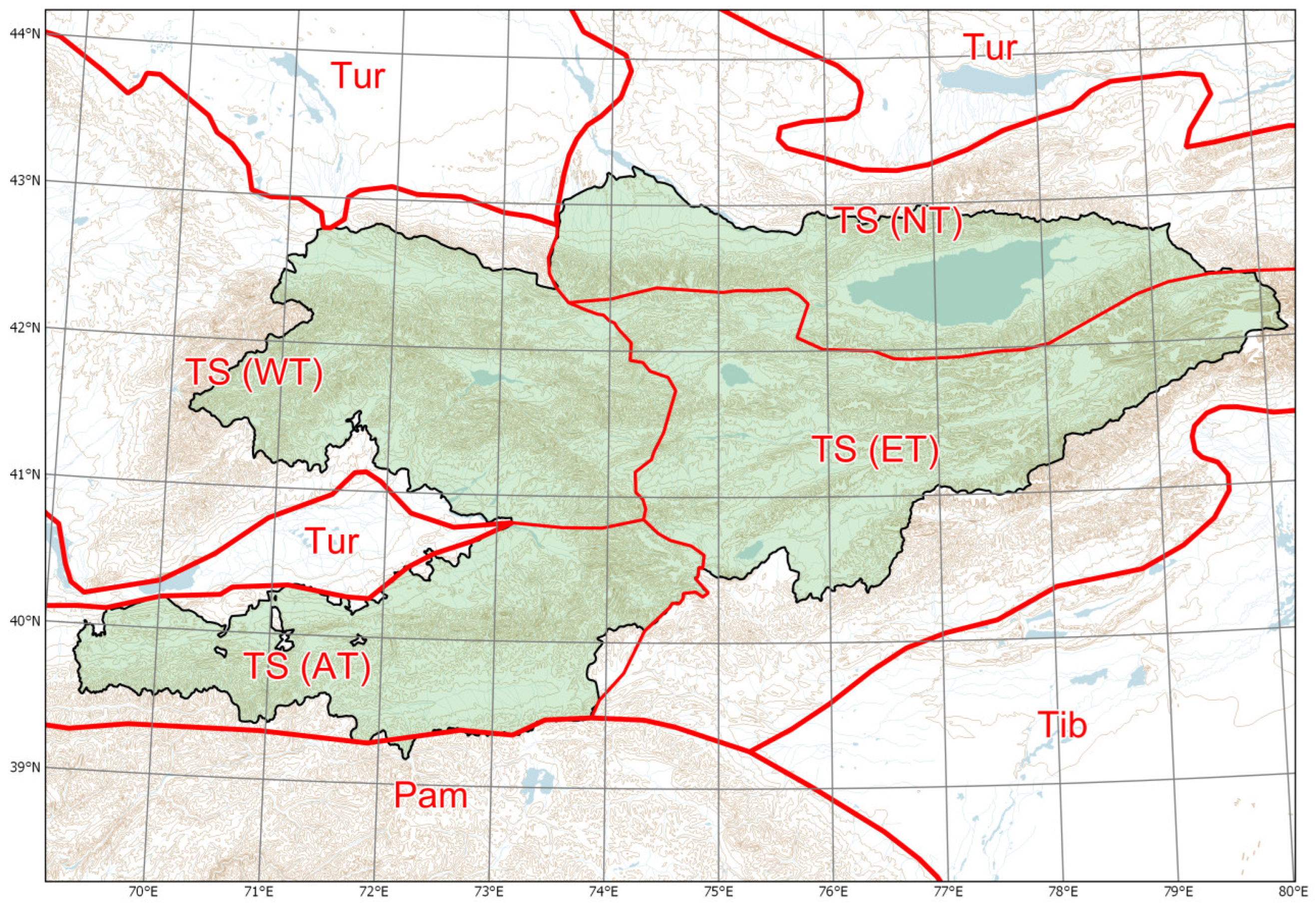
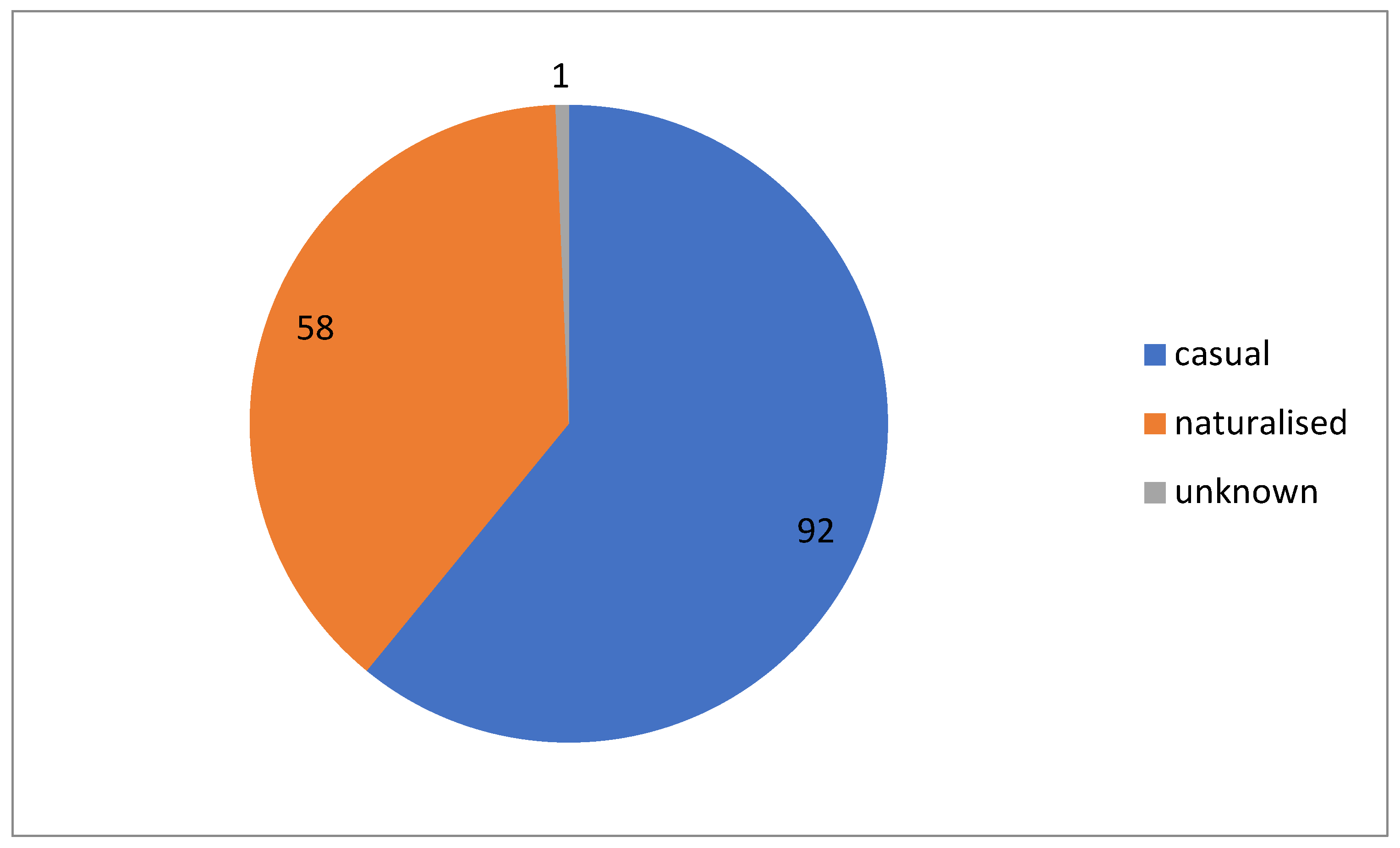

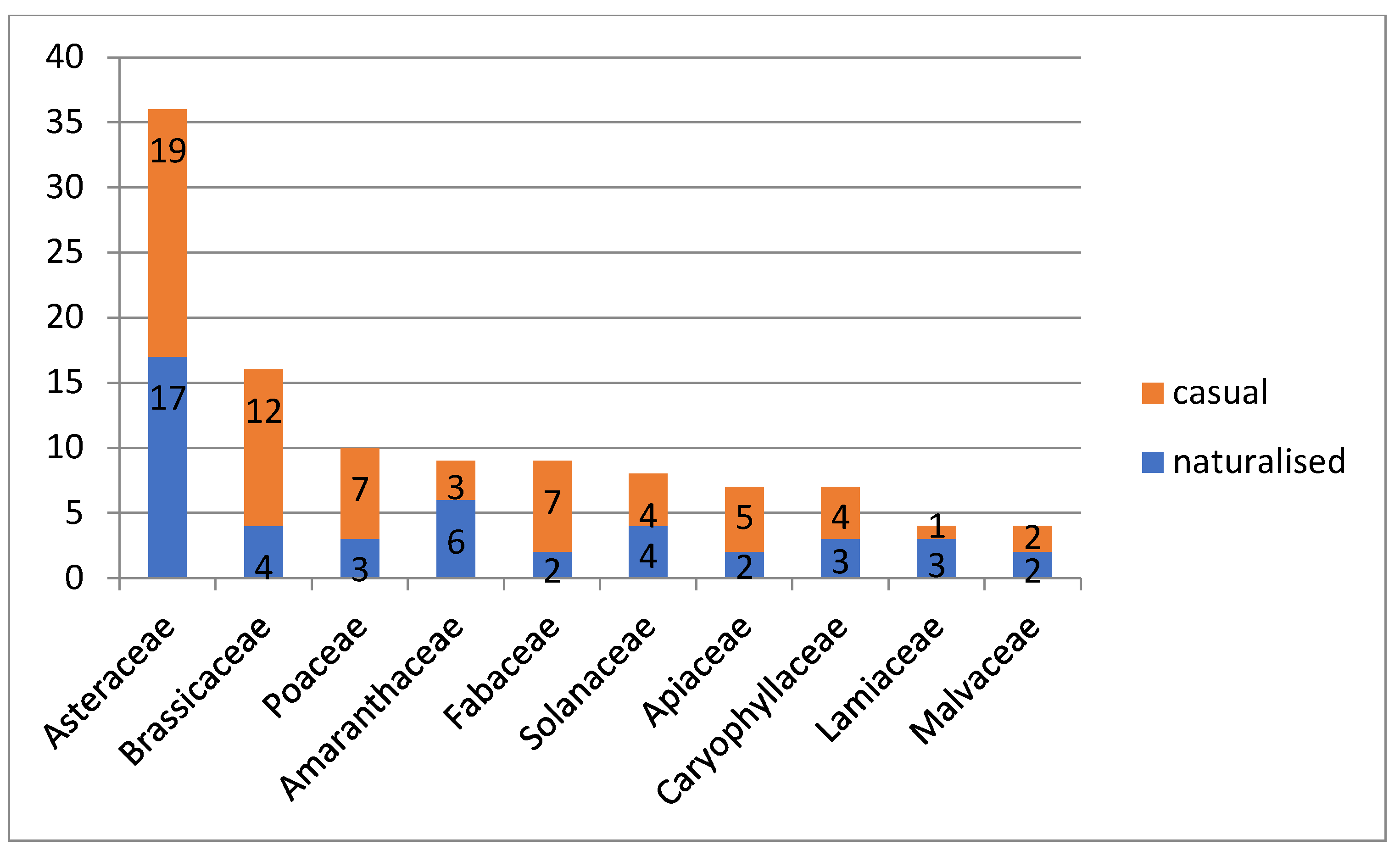
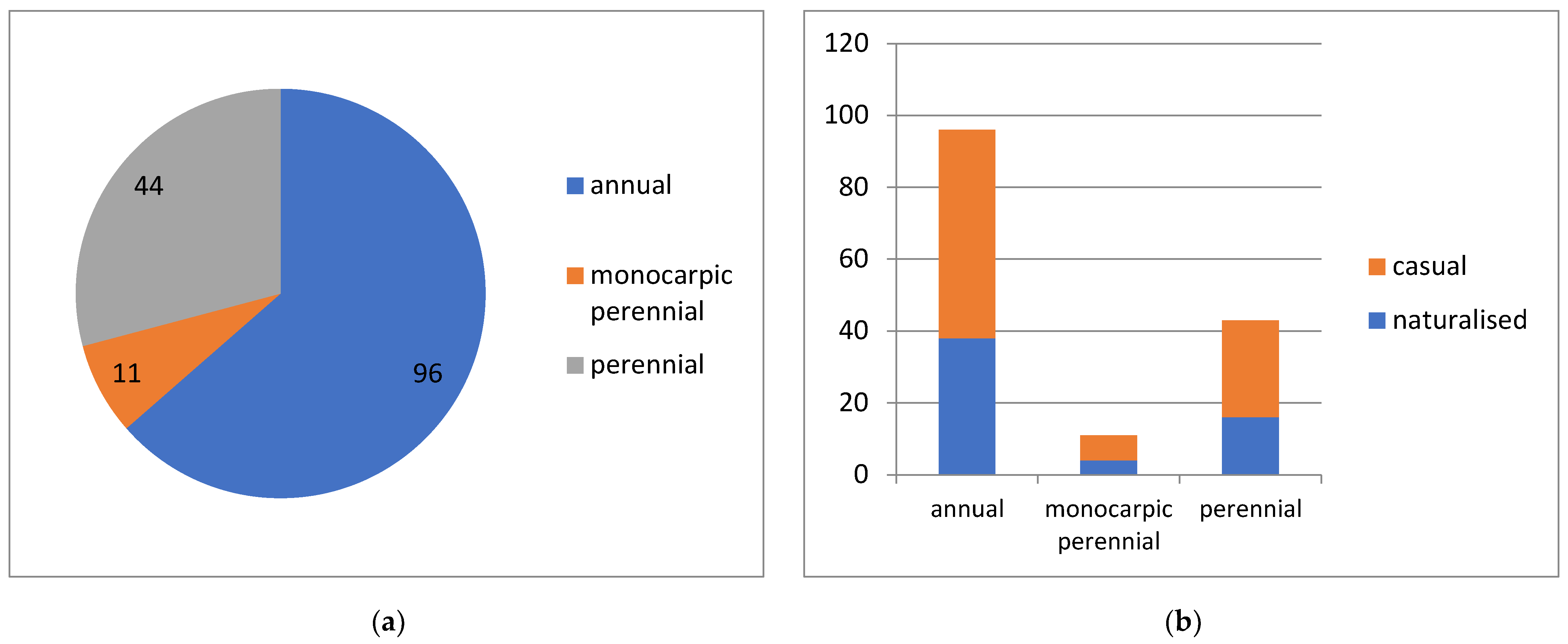
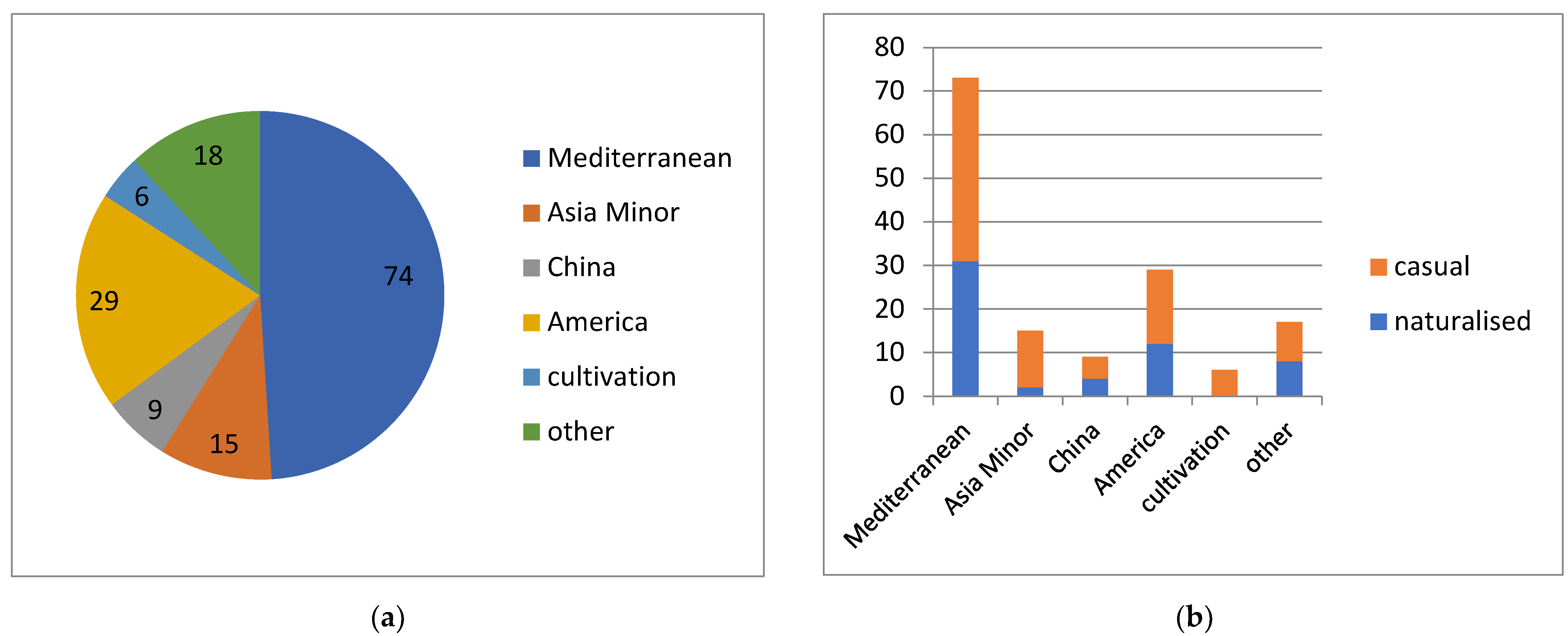
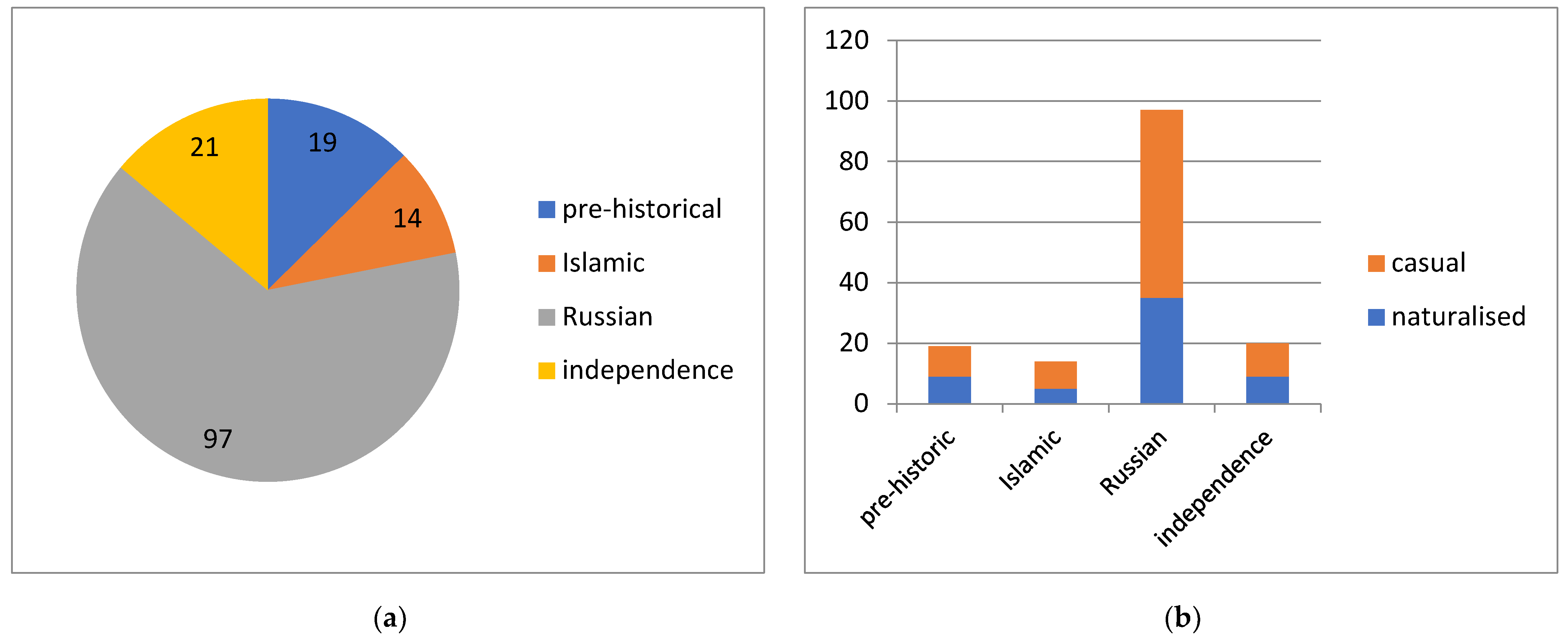
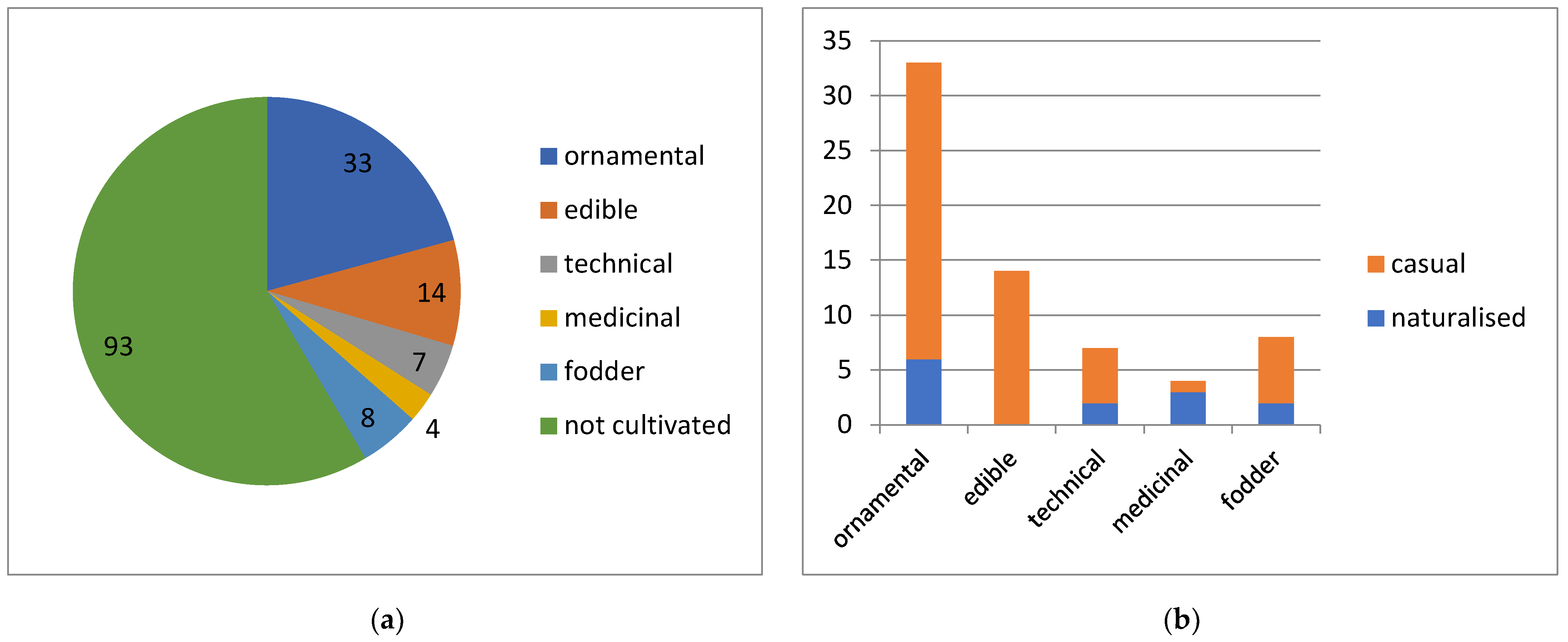
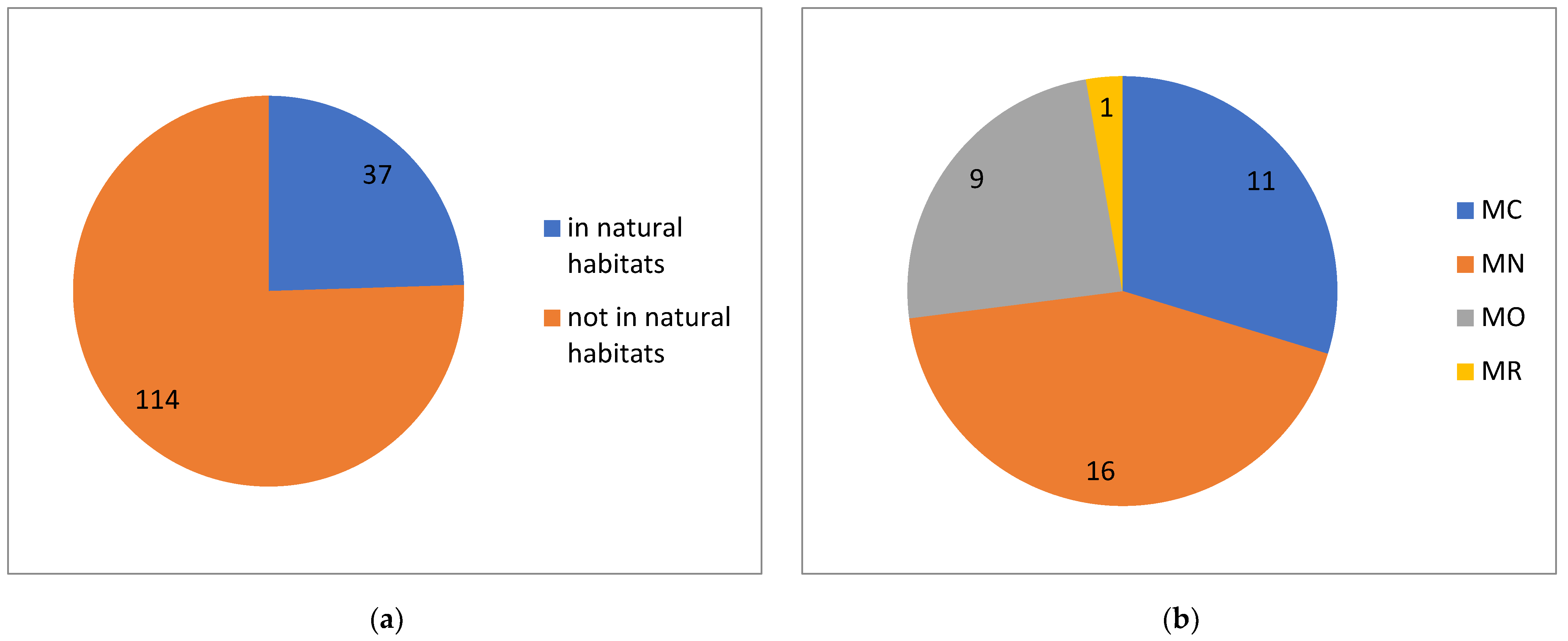
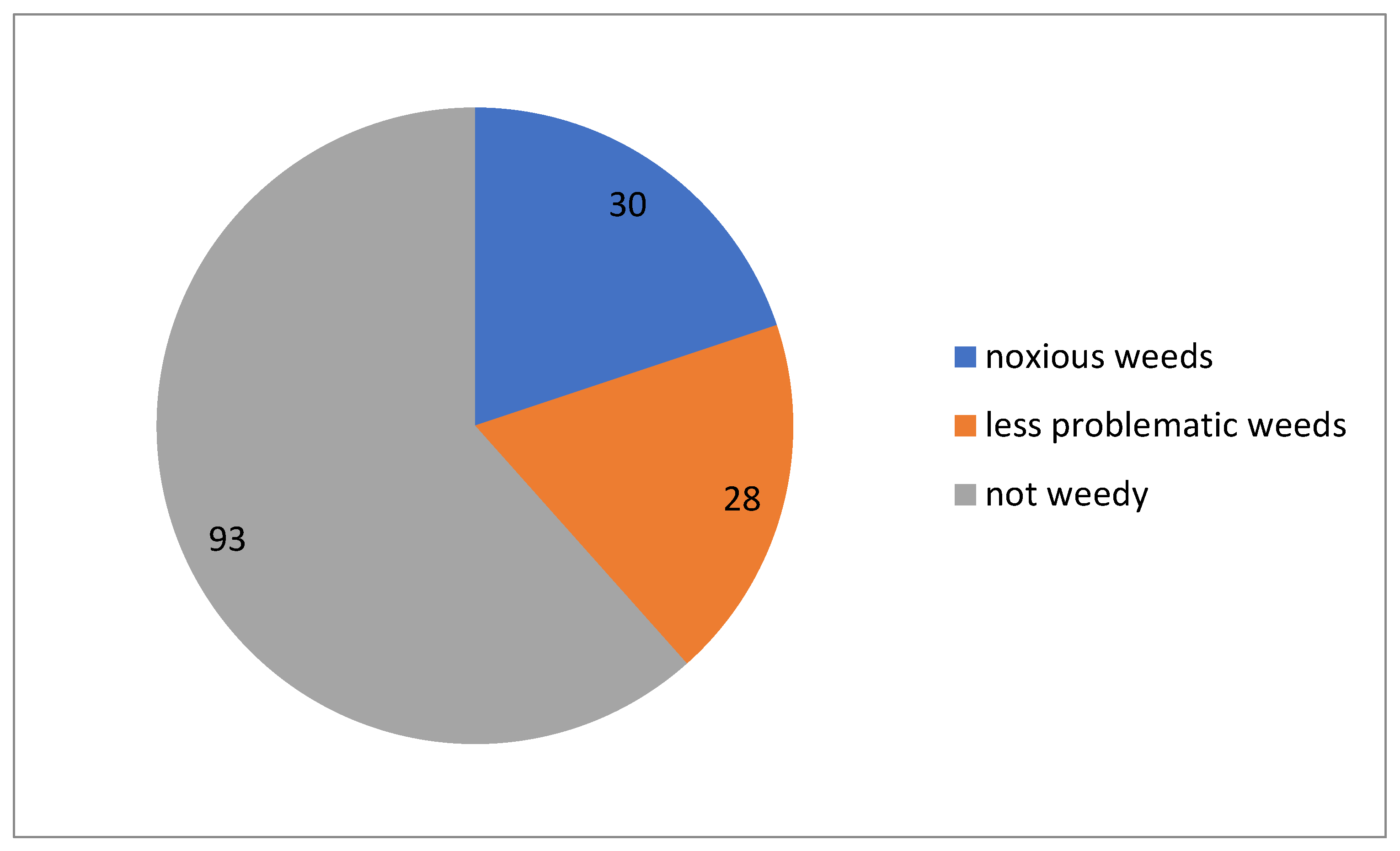
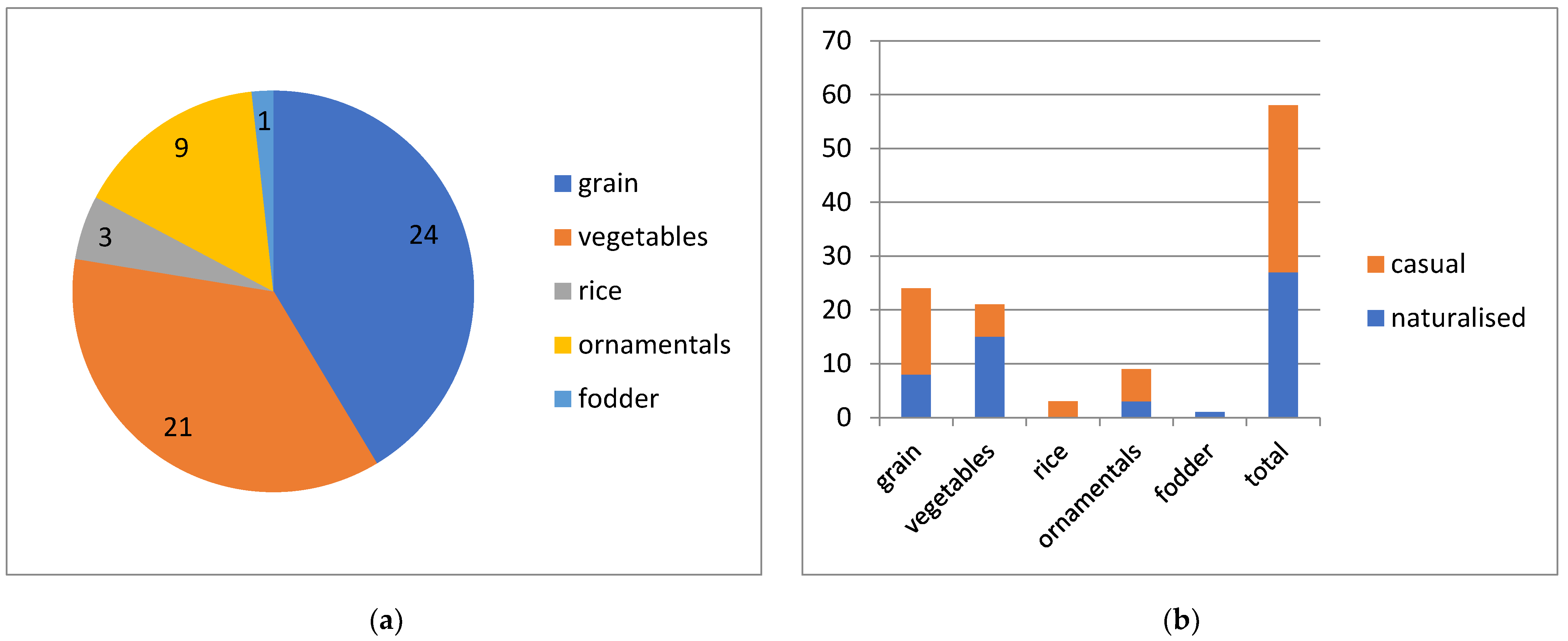

| Family | Scientific Name | Life Cycle | Period | Native Area | Occurrence | Impact |
|---|---|---|---|---|---|---|
| Asteraceae | Erigeron annuus | monocarpic perennial | independence | America | local | moderate |
| Asteraceae | Erigeron canadensis | annual | Russian | America | wide | moderate |
| Asteraceae | Pilosella aurantiaca | perennial | Russian | C Europe | local | moderate |
| Asteraceae | Xanthium orientale | annual | Russian | America | regional | moderate |
| Asteraceae | Xanthium spinosum | annual | Russian | America | regional | moderate |
| Asteraceae | Xeranthemum annuum | annual | Russian | Mediterranean | regional | moderate |
| Convolvulaceae | Cuscuta campestris | annual | Russian | America | regional | major |
| Convolvulaceae | Cuscuta chinensis | annual | Russian | China | regional | moderate |
| Orobanchaceae | Phelipanche aegyptiaca | annual | pre-historic | Mediterranean | wide | moderate |
| Simaroubaceae | Ailanthus altissima | perennial | Russian | China | local | moderate |
Disclaimer/Publisher’s Note: The statements, opinions and data contained in all publications are solely those of the individual author(s) and contributor(s) and not of MDPI and/or the editor(s). MDPI and/or the editor(s) disclaim responsibility for any injury to people or property resulting from any ideas, methods, instructions or products referred to in the content. |
© 2024 by the authors. Licensee MDPI, Basel, Switzerland. This article is an open access article distributed under the terms and conditions of the Creative Commons Attribution (CC BY) license (https://creativecommons.org/licenses/by/4.0/).
Share and Cite
Sennikov, A.N.; Lazkov, G.A. Alien Plants of Kyrgyzstan: The First Complete Inventory, Distributions and Main Patterns. Plants 2024, 13, 286. https://doi.org/10.3390/plants13020286
Sennikov AN, Lazkov GA. Alien Plants of Kyrgyzstan: The First Complete Inventory, Distributions and Main Patterns. Plants. 2024; 13(2):286. https://doi.org/10.3390/plants13020286
Chicago/Turabian StyleSennikov, Alexander N., and Georgy A. Lazkov. 2024. "Alien Plants of Kyrgyzstan: The First Complete Inventory, Distributions and Main Patterns" Plants 13, no. 2: 286. https://doi.org/10.3390/plants13020286
APA StyleSennikov, A. N., & Lazkov, G. A. (2024). Alien Plants of Kyrgyzstan: The First Complete Inventory, Distributions and Main Patterns. Plants, 13(2), 286. https://doi.org/10.3390/plants13020286






